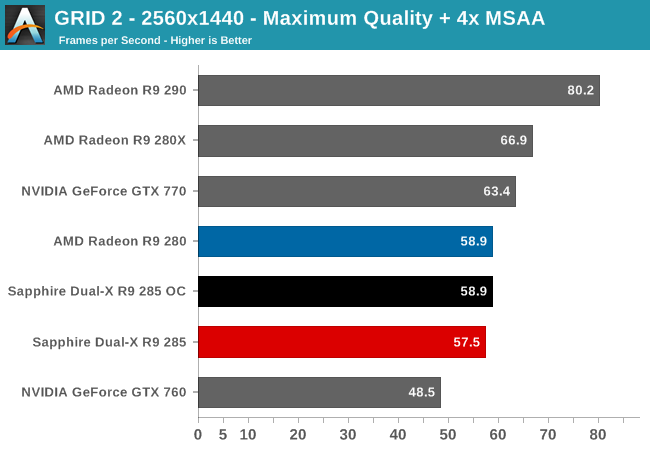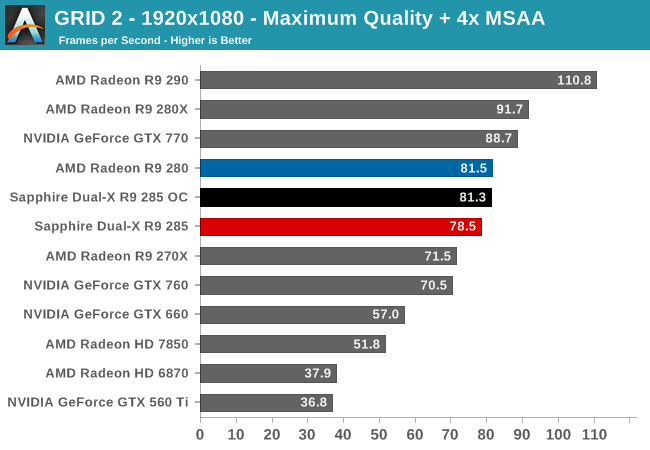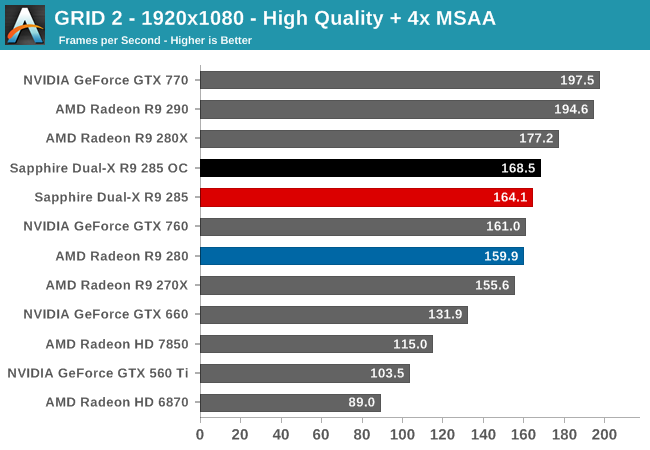AMD Radeon R9 285 Review: Feat. Sapphire R9 285 Dual-X OC
by Ryan Smith on September 10, 2014 2:00 PM ESTGRID 2
The final game in our benchmark suite is also our racing entry, Codemasters’ GRID 2. Codemasters continues to set the bar for graphical fidelity in racing games, and with GRID 2 they’ve gone back to racing on the pavement, bringing to life cities and highways alike. Based on their in-house EGO engine, GRID 2 includes a DirectCompute based advanced lighting system in its highest quality settings, which incurs a significant performance penalty but does a good job of emulating more realistic lighting within the game world.



Our final game sees the R9 285 and R9 280 close together, with cards either coming close to tying or trading the lead depending on the specific settings we use. Overall the use of color compression doesn’t seem to quite make up for the bandwidth loss, with the R9 280 generally taking a very small lead. For AMD in general however this is another strong game. The R9 285 has no trouble outperforming the GTX 760 at Maximum quality.










86 Comments
View All Comments
MrSpadge - Thursday, September 11, 2014 - link
The point is that Tonga is NOT a rebrand. It's a brand-new chip, AMD themselves call it the 3rd generation of GCN. Making a new chip costs AMD a sgnificant amount of money, that's why they haven't bothered yet to update Pitcairn to at least 2nd gen GCN (1.1). And I'm totally fine with that. It's also OK for nVidia to use GK104 for GTX760. What's not OK - from my point of view - is AMD investing into this new chip Tonga and hardly getting any real world benefit over the 3 year old Tahiti designs. If nVidia introduces a Maxwell which performs and costs them just the same as the previous Kepler, I'll call them out for this as well. But this is pretty much excluded, from what we've seen so far."And I highly doubt the 285 is 'all amd has'."
It's their 3rd gen GCN architecture, as they say themselves. There's going to be a bigger chip using this architecture, but apart from that I doubt we'll see anything from AMD in the next year which is not yet in Tonga.
just4U - Friday, September 12, 2014 - link
The one nice thing about the 285 is it will have resale value that has been lost on the 280-290 series thanks in large part to bit mining. There's a good chance that most won't feel that the 285 (and future incarnations) were run into the ground like the earlier ones were.Frenetic Pony - Wednesday, September 10, 2014 - link
Nah, what's interesting is that Maxwell may not be worth "responding" too. It's an almost totally mobile focused design, one that's not even totally out yet. If these benchmarks hold true then it's very exciting for AMD's upcoming high end. Nvidia may end up with a 512bit bus as well, but AMD's bandwidth optimizations will mean a similarly specced card of their's will still handily beat anything NVIDIA has in terms of resolution scaling.Heck it may even be enough to get a single GPU capable of running games at 4k at a reasonable fps. And that would be awesome. Maxwell might be good for Nvidia's mobile business, but I doubt it's going to help them take back the top spot for high end stuff from AMD.
mindbomb - Wednesday, September 10, 2014 - link
UVD always supported vc-1. The first version supported full decode of h264 and vc-1. You are thinking of nvidia, who didn't have full hardware decode on a real desktop part until fermi.mindbomb - Wednesday, September 10, 2014 - link
Not that it matters really. It stopped being relevant when hd-dvd lost to bluray.Navvie - Thursday, September 11, 2014 - link
A lot of blu-rays have vc-1 content.nathanddrews - Thursday, September 11, 2014 - link
Blu-ray.com has a database that you can search by codec. VC-1 is very much alive and thriving.Ryan Smith - Wednesday, September 10, 2014 - link
According to my DXVA logs, the 280 did not support VC-1/WMV9. That is what I'm basing that on.mindbomb - Wednesday, September 10, 2014 - link
I think your logs are referring to the nvidia gtx 280, which did not support full vc-1 decode. AMD had it since the radeon 2600xt, which is ancient.NikosD - Saturday, September 13, 2014 - link
True.One of the main advantages of first generation UVD (ATI Radeon HD2000 series) over Nvidia, was the full DXVA VLD support of both 1080p H.264 L4.1 (BluRay spec) and VC-1.